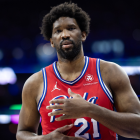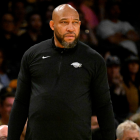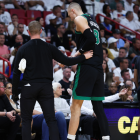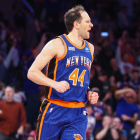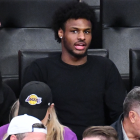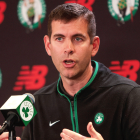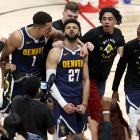Jason Terry couldn’t believe it. Over the course of nearly two decades in the NBA, he took pride in embodying a cliché: first in the gym, last to leave. When he arrived in Milwaukee last September, he couldn’t claim that distinction. Every time he showed up, morning and night, a familiar 6-foot-11 figure was already there.
Giannis Antetokounmpo had just signed a four-year, $100 million contract extension with the Bucks, but there he was, all of 21 years old, watching film after a workout. Terry saw him studying Scottie Pippen, Shawn Marion, Magic Johnson and Shawn Kemp, a fitting group for Antetokounmpo and maybe no other basketball player on Earth aside from LeBron James.
When Sports Illustrated put the Greek Freak on its cover in January, one particular anecdote went viral: The first time Milwaukee coach Jason Kidd benched him, an “irate” Antetokounmpo decided to look up what exactly Kidd had accomplished as a player. Humbled by seeing that Kidd won Rookie of the Year, an NBA championship, two Olympic gold medals and was second all-time in assists, he realized he couldn’t compete with all that and decided “I better zip it.” That was April 2015, though; since then, he has made up for lost time.
Antetokounmpo said he watches Kidd’s old highlights “all the time -- it’s so amazing. My favorite game was him against Steve Nash.” It was December 2006, and the Suns and Nets went to double-overtime. Kidd had 38 points, 14 rebounds and 14 assists. Nash had 42 points, six rebounds and 13 assists. After winning 161-157, then-Phoenix coach Mike D’Antoni called it “the best game I’ve ever seen.”
“It was an unbelievable game,” Antetokounmpo said. He then made it clear that his continuing NBA education is wide-ranging. “I always go watch clips of every player, not just Jason Kidd.”
Antetokounmpo watches the best of the best because he knows he’ll be measured against them. In his fourth season, he is already an All-Star starter and a franchise player. He would be on a maximum contract if he hadn’t given the Bucks a discount. High hopes are gradually being replaced by high expectations for both him and his organization. How do you maximize your potential when everybody says it’s limitless? How do you develop somebody who can seemingly do everything?
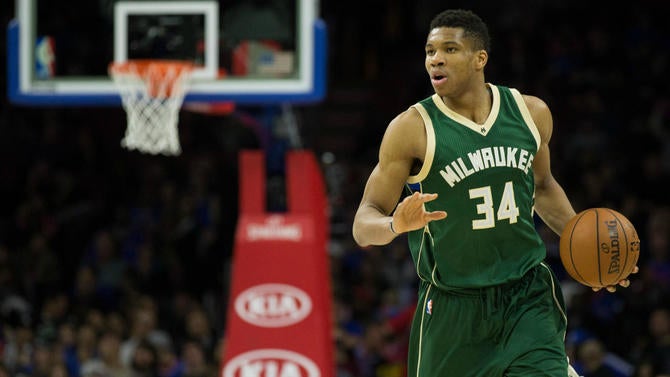
The first thing Bucks coaches talked about was his length. Antetokounmpo arrived in 2013 with a thin frame that made his 7-foot-4 wingspan look even longer. Up close, they saw the same thing that you could see in the grainy clips from the Greek second division: possibility.
“It was kind of like a kid in a candy store,” former Milwaukee assistant coach Nick Van Exel said. “And I think we were the kids and he was the candy.”
Antetokounmpo could move and handle the ball like a man six or seven inches shorter. He had never played against NBA competition, though, and he wasn’t far removed from hawking purses and toys on the streets of Athens. There was plenty of work to do.
“The first day he got to the country, we played one-on-one,” Bucks big man John Henson said. “He couldn’t get a shot off. He couldn’t score.”
Unlike other prospects hyped for their athleticism and physical attributes, it turned out that Antetokounmpo was most impressive in a team context. He always thought of himself as a creator, and he couldn’t exactly use his court vision when he was playing one-on-one.
“Once he starts playing, you’re just amazed at his IQ level of the game, him seeing the floor so well, him being able to handle the ball so well, him being able to create opportunities for himself and his teammates,” Van Exel said. “You saw all those things early on.”
The Bucks planned to bring him along slowly, but they gave him a shot in the preseason. Just like in practices, he was active, disruptive on defense and doing a bit of everything. They couldn’t keep him out of the rotation, and with the team struggling in December, they decided to expand his role.
Van Exel and Antetokounmpo worked together after practices. Van Exel “tried to foul him a lot, tried to beat him up a lot just to make him feel uncomfortable,” he said. He taught the rookie how to use his body and showed him proper footwork in the post. He encouraged him to use his jump hook because his release was so high that no one could block it. Van Exel often had to tell him to stop playing around when practicing free throws. He also often had to tell him to go home.
“He was so competitive,” Van Exel said. “He hated having bad games. He hated to leave the gym. I don’t know if it was because he didn’t like his apartment or what it was, but he just didn’t want to go back. He would stay in the gym, and I’m telling you, just run around. Just like a little kid. He was like a little kid, but he was focused on getting better. He was focused on improving his game.”
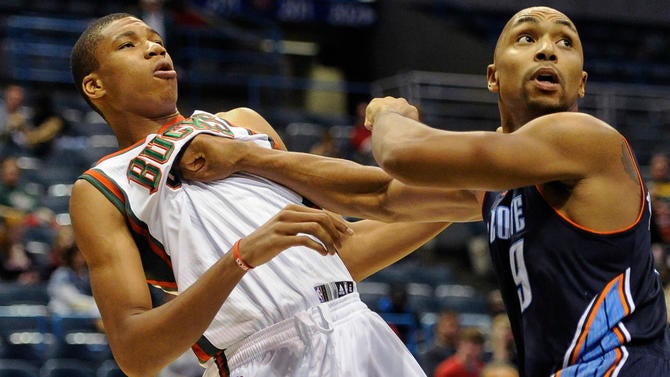
Immediately, Antetokounmpo was a wonderful story. ESPN called him a prodigy who could combine “Scottie Pippen’s game with Magic Johnson’s personality.” Scott Brooks, then the coach of the Oklahoma City Thunder, told SI he had “a skill set like Kevin Durant.” Antetokounmpo tweeted about having a smoothie for the first time and the internet went nuts.
Fans fell in love with his ebullience. They didn’t see the moments where he was hard on himself and missing his family. His parents and two younger brothers didn’t move to Milwaukee until February 2014 because of visa issues, so he Skyped with them daily.
“He was so young, so energized, had so much energy,” Van Exel said. “I don’t even think he realized he was in the NBA yet. No, seriously, he was worried about his family coming over. That was a big burden on him. He was so strong-willed that he could easily block that out once he got on the court.”
The Bucks simply tried “to always be supportive and encouraging for him,” general manager John Hammond said. His teammates might have seen him as a little brother, but he had to act like an adult.
“Obviously you could see his potential and the abilities that he had, but sometimes it’s not easy for young players,” Hammond said. “A major transition for a guy like Giannis. Moving from Athens, Greece, to Milwaukee, relocating his family, who moved with him. So many things happened in his life that the responsibility that he had on his shoulders, not only from a basketball standpoint, but from a personal standpoint.”
Hammond, who taught driver’s education in Nebraska decades earlier, picked up a new student. Antetokounmpo didn’t pretend he had any idea what he was doing behind the wheel, but his team got him ready for his test. Sometimes it would just be Antetokounmpo and Hammond; other times executives Jon Horst and Dave Dean were in the car, too. Hammond called it “a very festive day” when Antetokounmpo eventually got his licence.
“We were driving this little Ford car with his knees up, up way above the steering wheel, watching him drive and teaching him how to park,” Hammond said. “It was great times.”
The picture of Antetokounmpo as an earnest, happy-go-lucky manchild wasn’t entirely inaccurate. It was incomplete, though. His teammates noticed his competitiveness. He battled players much stronger than him. Opposing stars didn’t intimidate him.
“We would always tell him to get serious cause he’s just always joking, running around, laughing, you know, hitting people upside the head and running, throwing things at people and running,” Van Exel said. “But when he did step inside the rectangle, he was always focused. He never really joked around when it came to practice. He never joked around when it came to him working on his game. He’s a big kid with a great heart, but when it comes to competing, he’s not a kid at all. He’s a savage.”
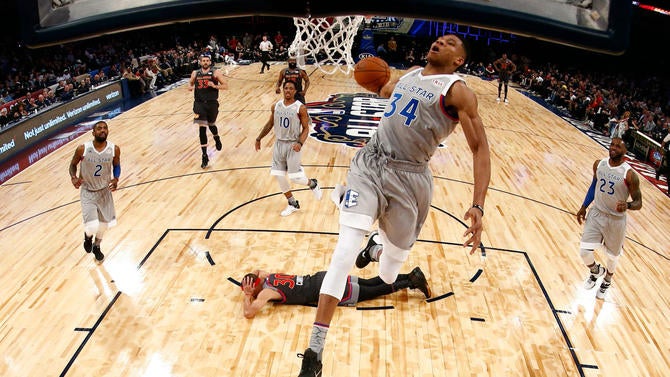
Watching Antetokounmpo now, you never know what you’re going to see. He might catch the ball at the 3-point line, take one dribble, start his gather behind the free throw line and elevate for a two-handed dunk, briefly bringing the ball down and to his left to evade a defender before flushing it. He might poke the ball away from a big man, recover it, race down the floor and flip a perfectly placed behind-the-back pass to a teammate for an easy bucket. He might catch a pass at half court, take two dribbles, the second to scoot around an opponent, and launch into a twisting, one-handed dunk, ducking his head to avoid hitting it on the backboard.
He might even do all those three things in one quarter. That happened last week against the New York Knicks, a game in which he had 32 points, 13 rebounds, seven assists, two blocks and four steals.
Even teammates marvel at what Antetokounmpo has become. He is Milwaukee’s point guard on offense, but his versatility makes the concept of positions seem obsolete.
“It’s crazy,” former Bucks forward Steve Novak said. “You see in some games we have Giannis guarding Anthony Davis. It’s a 1 vs. 5 and they’re the same size almost. It’s just crazy to have seen it a couple years ago and had said possibly he would be an NBA point guard because you just hadn’t seen that kind of guy. But he’s doing it at an elite level so there’s no reason at this point to say that anything’s impossible.”
In January, Antetokounmpo hit a buzzer-beating stepback jumper to defeat the Knicks at Madison Square Garden. Afterward, he said he “just let it fly” because all his time in the gym “eliminates fear.” He had worked with assistant coach Sean Sweeney on that shot consistently, so to him, it was instinctual. In other games, when he messed up a certain post move, Henson would notice him doing it over and over with Sweeney the next morning.
Henson is happy to finish plays when Antetokounmpo draws double- and triple-teams, and he said that, even at 22 years old, Antetokounmpo sets an example for the rest of the team. As young and well-paid as he is, he wouldn’t have the respect of the locker room if he didn’t handle himself like a pro.
“I just don’t think it would work,” Novak said. “If you’re not wired a specific way and you’re given the responsibility of a franchise and all that pressure is put on your back, there’s just no way for it to work. The organization has to have plans and they have to kind of give him the reins and that’s part of it, but he’s a guy who has to, I think, have his own motivations and his own goals and his own thoughts. If you’re a guy that just says, ‘OK, I’ll do what you ask,’ you can only get so far. He’s a guy who really wants to be great himself.”
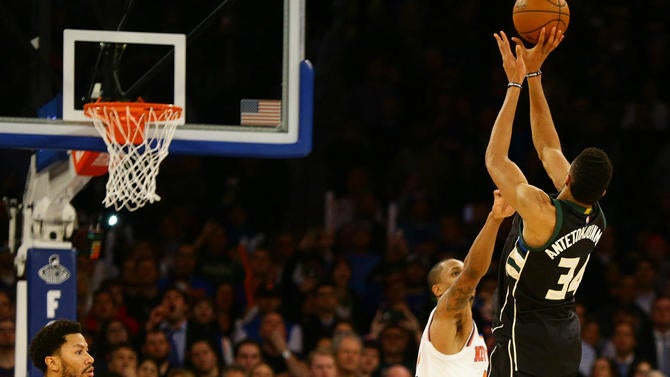
Antetokounmpo’s numbers are staggering. Per Basketball-Reference, he ranks eighth in the NBA in PER, fifth in win shares, 18th in true shooting percentage, sixth in block percentage and 20th in steal percentage. He is also ninth in ESPN’s real-plus minus. No one in NBA history has been in the top 20 in total points, assists, rebounds, blocks and steals for a full season, which Antetokounmpo is on pace to do.
The Bucks, though, are more excited about what kind of player he could be in a few years. When Antetokounmpo was leading the team in every major statistical category in December, Kidd stopped holding back his lofty comparisons.
“You have special players that we come across,” Kidd said. “LeBron James, Kobe Bryant, Michael Jordan. You have different players that are rare, and Giannis is one of those rare birds that we’ll be able to enjoy for a long time.”
Perhaps the most unbelievable part of Antetokounmpo’s ascension is that he has done it without a reliable outside jump shot. Teams still dare him to shoot from deep because he has only made 31.5 percent of his shots outside of the paint. He’s second in the league in points in the paint per game, though, and fifth in fast-break points.
The way he plays, Antetokounmpo doesn’t have to make jumpers to be a superstar. If he ever becomes a threat from the outside, though, it will make everything else easier. He knows this, and he’s trying to keep the ball high on the catch, shoot without hesitating and hold his follow through.
“It’s just a matter of repetition, and he’ll get it,” Van Exel said. “Once he gets that shot down, that 3-point shot, you can forget it.”
Hammond defines franchise players simply: “They win.” In that regard, there are no worries about Antetokounmpo, despite the fact that Milwaukee is under .500. Hammond raves about Antetokounmpo’s drive and desire, adding that he cares about the community, the organization and his teammates. At his exit meeting last season, Hammond didn’t challenge him or tell him he had to take a massive leap forward -- that kind of push wasn’t necessary. When he asks Kidd about being the No. 1 guy, the soon-to-be Hall of Famer just tells him to play his game and be himself.
“It’s hard,” Antetokounmpo said. “To be a leader every night, it’s not easy. But I accept that responsibility. You just gotta step up. It doesn’t matter how old are you. If you’re 22, 21, 20, if you’re the leader of the team, you gotta step up, you gotta always be vocal, you gotta talk more. I accept that role and it’s not an easy role, but that’s what my team wants me to do. And that’s what I’ll do.”
With Antetokounmpo leading the way, the Bucks are playing their best basketball of the season at the perfect time. They were on a six-game winning streak until Monday, and they own the eighth spot in the East. Terry, who has spent all season invoking the names of LeBron, Pippen and Dirk when discussing Antetokounmpo, has noticed him being more willing to speak up. The veteran sees “tremendous leadership qualities” that will be more evident in a couple of years, and he’s not the least bit concerned about putting too much pressure on him.
“To whom much is given, much is required,” Terry said. “And he understands that. I think he welcomes that challenge. That’s why he will be one of the greats.”














